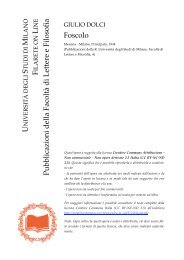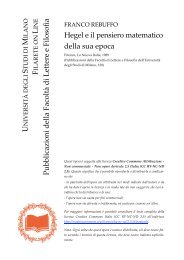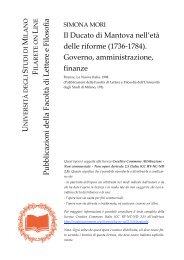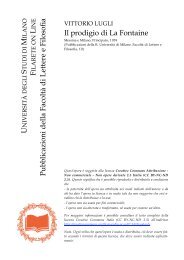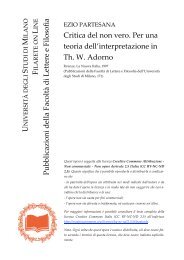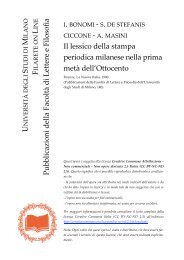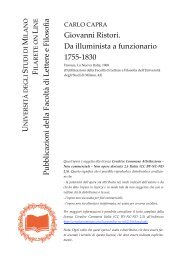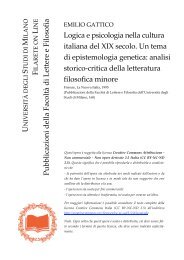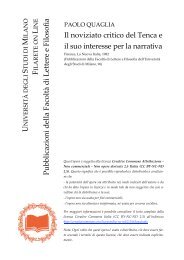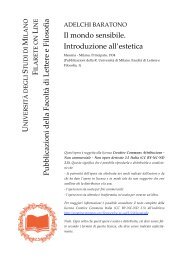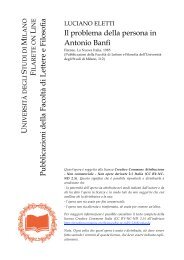U S M F L P u bblicazion i della Facoltà di Lettere e Filosofia La ...
U S M F L P u bblicazion i della Facoltà di Lettere e Filosofia La ...
U S M F L P u bblicazion i della Facoltà di Lettere e Filosofia La ...
You also want an ePaper? Increase the reach of your titles
YUMPU automatically turns print PDFs into web optimized ePapers that Google loves.
LE TEORIE DEGLI STILI E LA TEORIA DEI GENERI 119<br />
non sono le medesime, vogliono non<strong>di</strong>meno significare il medesimo », p.<br />
347), ma anche la frequenza <strong>di</strong> « congiuntioni »; le perifrasi; qualche<br />
« vaga similitu<strong>di</strong>ne & interrogatione »; le facezie, i bisticci, gli isocola<br />
(questi due ultimi qui nominati espressamente, per quanto già poten<br />
zialmente compresi nella parte sulle ripetizioni e sulle simmetrie), gli<br />
omoteleuti, le antitesi; varie figurae sententiae e, infine, la litote*.<br />
Quanto al numero esso « debbe essere tale che paia che e' penda nell'har-<br />
monia del verso, havendosi però riguardo a non cader nel verso & nel<br />
numero poetico ». <strong>La</strong> bellezza — si intende — è una forma altamente ar<br />
tificiosa, che ricerca l'armonia, l'euritmia, la concinnità*, ma, come da<br />
tra<strong>di</strong>zione, bisogna guardarsi dall'affettazione e perciò ricorrere alla va-<br />
riatio e al temperamento, specie per quegli ornamenti (isocola, omote<br />
leuti, antitesi, bisticci) che già altrove il Cavalcanti aveva, anche qui se<br />
condo tra<strong>di</strong>zione, definito « gorgiani », e che son tali che se « troppo<br />
frequentemente & scopertamente usati potrebbono far parer quella bel<br />
lezza affettata & più tosto <strong>di</strong>minuirebbono che accrescerebbono la sua<br />
naturai <strong>di</strong>spositione, generando insieme satietà & fasti<strong>di</strong>o» (p. 438) 51 .<br />
<strong>La</strong> « glykytes » o « dolcezza », che è una delle forme particolari<br />
del?« éthos », è abbastanza simile alla « bellezza », ma ha un minor<br />
grado <strong>di</strong> artificiosità: infatti è una sorta <strong>di</strong> commistione <strong>di</strong> purità, sem<br />
plicità (da cui si attingono parole, modo e figure) e bellezza (da cui si<br />
attingono testura e figure); minor incidenza, infine, ha la degnità da cui<br />
si attingono finimento e numero (clausole <strong>di</strong> almeno tre sillabe). Pecu<br />
liari <strong>di</strong> questa forma sono i concetti, cui si ad<strong>di</strong>cono narrazioni favolose,<br />
argomenti soavi, lo<strong>di</strong> degli antichi, <strong>di</strong> sé, dei fanciulli, tutto ciò che ap<br />
pare piacevole (mentre la bellezza non ha concetti suoi propri, è cate-<br />
50 II Trapezuntius sinteticamente: « Schemata pulchra sunt: repetitiones, con-<br />
versiones, reversiones, gradationes, traductiones, membra, <strong>di</strong>siunctiones, transgres-<br />
siones, circuitiones, coniugatae partitiones, innovationes, per negationem affirmatio,<br />
convolutio » (1493, foglio p ii vs).<br />
51 L'ammonizione alla varietas è già nel Trapezuntius (1493, foglio p iii vs),<br />
da cui il Cavalcanti spesso attinge. Si consideri anche quanto scrive la Patterson:<br />
« Beauty uses an elegantly polished Diction, but avoids long, <strong>di</strong>fficult, or awe-<br />
inspiring words. Whereas Magnificence uses an even rhythm for thè sake of <strong>di</strong>-<br />
gnity, and Clarity does so to avoid <strong>di</strong>straction from thè sense, Beauty elevates<br />
smoothness of Number into its most characteristic virtue, and seeks above ali<br />
things a smooth sweet flow of sound. Similarly whereas Circumlocution ìs marked<br />
by its use of thè figures of complex syntax, which demand alertness in thè au<strong>di</strong>ence<br />
and command its respect, Beauty is marked instead by figures which are au<strong>di</strong>bly<br />
pleasing, emotionally moving in a mild way, but not intellectually deman<strong>di</strong>ng,<br />
su<strong>di</strong> as epanastrophe or epanaphora» (1970, p. 54).



